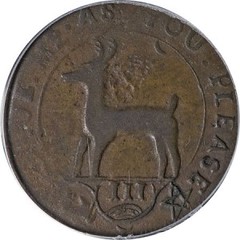
PREV ARTICLE
NEXT ARTICLE
FULL ISSUE
PREV FULL ISSUE
ARTICLE HIGHLIGHTS HIGLEY COPPERS
An article by Greg Reynolds in CoinWeek April 3, 2013 highlights one of my favorite U.S. colonial coins, the Higley Copper. There's a lot of detail bibliophiles will appreciate. Be sure to read the complete article online.
-Editor
On Wed, March 13, at a convention center in Baltimore, Stack’s-Bowers auctioned two Higley Coppers, both of which were in the Ted Craige Collection. Probably from 1737 to 1739, these copper pieces were minted in Connecticut. Circumstantial evidence strongly suggests that Samuel Higley was very much involved, though claims in standard coin references regarding his role are misleading. He did not singlehandedly mine copper, craft dies and mint coins. The Higley family was prominent in the area and there is historical evidence that two of Samuel’s associates were geared towards producing coins. Some researchers have classified Higley Coppers as “tokens.” In my view, these are true coins, not tokens. Circumstantial evidence and logic dictate that these circulated to a large extent as a general medium of exchange. Thousands must have been minted. There was a perennial shortage of coins, especially small denominations, in the British colonies of North America. Besides, there is no reason to believe that Higley Coppers were used in just one neighborhood or for just one kind of transaction. It is likely that a large number and a variety of sellers accepted Higley Coppers in transactions for goods and services. Noah Phelps wrote a History of Simsbury, Granby and Canton [Connecticut], which was published in 1845. Current accounts of the Higley coinage often rely on secondhand interpretations of the material in this book. Noah Phelps specifically mentions “Higley’s Coppers” on page 118. These were “in some circulation in the vicinity of the mines. [Each] is said to have passed for two and sixpence, forty-two cents, in paper currency … One of these coins, dated 1737, is in the cabinet of the Connecticut Historical Society. Its inscription on one side is, ‘I am good copper’ [and] on the other, ‘Value me as you please’… The inventor and maker, is supposed to have been Doct. Samuel Higley,” Noah Phelps adds. A later book by Richard Harvey Phelps, presumably one of Noah’s relatives, discusses the history of these mines and of Newgate prison, which was built on Copper Hill. Sylvester Crosby, in his epic reference, The Early Coins of America (1875), does not clearly distinguish between the two Phelps and their respective writings. This could be partly because Richard sometimes copied material from Noah without identifying such materials as being cited, and Richard seems to have carelessly interpreted some of Noah’s passages. Crosby’s work, in turn, became the basis for the understanding of Higley’s Coppers attained by many collectors from 1875 to the present. My impression is that Crosby relied heavily on Richard’s writings. Also, Richard Phelps, or an editor of the 1901 edition of Richard’s book, seems to have illicitly copied material from Montroville Dickeson’s book, American Numismatical Manual, which was published in 1859. Here is one such sentence that seems to have been plagiarized; “These coins grace but few cabinets, having been generally so impaired by wear, from being stamped upon unalloyed copper, as to be rarely found sufficiently perfect” (Richard Phelps, 1901, p. 20; Dickeson, 1859, p. 80). Phelps or an editor deleted the phrase “at this time,” which Dickeson used in the middle of this sentence. It is otherwise the exact same sentence. In regard to Higley Coppers, Dickeson’s book is of extraordinary importance. It demonstrates that five of the seven subtypes that are now known were identified before 1859. One of other two was not discovered until the 20th century, and is represented by a single coin.
To read the complete article, see:
Coin Rarities & Related Topics: Historically Important Higley Coppers Always Draw Attention!
(www.coinweek.com/featured-news/coin-rarities-related-topics The Numismatic Bibliomania Society is a non-profit organization promoting numismatic literature. See our web site at coinbooks.org. To submit items for publication in The E-Sylum, write to the Editor at this address: whomren@gmail.com To subscribe go to: https://my.binhost.com/lists/listinfo/esylum All Rights Reserved. NBS Home Page Contact the NBS webmaster 
|
